Mission profiles of early Soviet lunar probes
Sven Grahn
Contents
List of launches
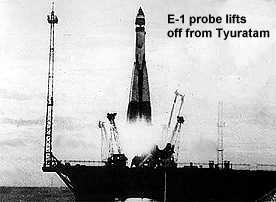 The
table below lists the known launches in the E-1, E-2, and E-3 series of
lunar probes. It is also known that the first E-1 probe was scheduled for
August 18, 1958, but postponed to September 1958 when the first U.S. Pioneer
probe failed on August 17(2). The next attempt
took place on 23 September, i.e. at roughly the same lunar age as that
of the planned attempt the month before. When the launch attempt failed
on 23 September the pressure to beat the U.S. to the Moon caused Korolev
to launch the next rocket to compete with the next Thor-Able Pioneer probe
planned to be launched on 11 October 1958.
The
table below lists the known launches in the E-1, E-2, and E-3 series of
lunar probes. It is also known that the first E-1 probe was scheduled for
August 18, 1958, but postponed to September 1958 when the first U.S. Pioneer
probe failed on August 17(2). The next attempt
took place on 23 September, i.e. at roughly the same lunar age as that
of the planned attempt the month before. When the launch attempt failed
on 23 September the pressure to beat the U.S. to the Moon caused Korolev
to launch the next rocket to compete with the next Thor-Able Pioneer probe
planned to be launched on 11 October 1958.
No lunar age constraint?
As can be seen from the figure
below the table the 11 October 1958 E-1 attempt took place at a much different
lunar age than the previous one. Everything to beat the U.S.! Even the
next launch, on 4 December, seems to have been timed to precede the first
attempt by the US Army team to reach the Moon. The Luna 1 launch occurred
roughly a month later. The two remaining launches in the E-1 lunar impact
program occurred at roughly the same lunar age as that in September 1958.
It seems that there was no specific boundary conditions for the launch
of the E-1 probes that directly related to the age of the Moon. As we shall
see later, there was probably another criterion that determined the launch
window. The data in the table comes from many sources (3).
The arrival times for the
E-1 launch failures are based on a flight time of 38 hours and 41 minutes
(the same as for Luna 2) and 61 hours 33 min for the E-3 failures (same
flight time as Luna 3).
| Name |
Type |
Date |
Time (UT) |
Notes |
Arrival time |
Declination
at arrival |
| - |
E-1 |
23 Sep 1958 |
0703:23 |
Exploded at T+93 sec due
to resonance oscillations |
24 Sep
2144 UT |
-18.7 |
| - |
E-1 |
11 Oct 1958 |
2141:58 |
Exploded at T+104 sec due
to resonance oscillations |
13 Oct
1223 UT |
-10.5 |
| - |
E-1 |
4 Dec 1958 |
1818 |
Core stage engines failed
at T+245 sec |
6 Dec
0859 UT |
-5.5 |
| Luna 1 |
E-1 |
2 Jan 1959 |
1641:21 |
Missed the moon by 6400
km |
4 Jan
0259 UT |
-11.8 |
| - |
E-1A |
18 Jun 1959 |
0808 |
Inertial guidance system
failed at T+153 sec |
20 Jun
2249 UT |
-18.3 |
| Luna 2 |
E-1A |
12 Sep 1959 |
0639:42 |
Hit Moon at 2102:22 UT on
13 Sep 1959 |
13 Sep 59
2102:22 UT |
-13.5 |
| Luna 3 |
E-2A |
4 Oct 1959 |
0043:40 |
Closest approach to Moon
at 1416 UT, 6 Oct 1959 |
6 Oct
1416 UT |
-18 |
| - |
E-3 |
15 Apr 1960 |
1506:44 |
Engine of Block-E cut off
too early. Apogee 200,000 km. |
18 Apr
0439 UT |
-16.9 |
| - |
E-3 |
16 Apr 1960 |
1607:43 |
One strap-on did not reach
full thrust. Broke away at T+0.4 sec. |
19 Apr
0440 UT |
-14.5 |
It is interesting to note
that Pioneer 1 was launched at 0842 UT on 11 October 1958, i.e. 13 hours
before the Soviet E-1 probe. However, the flight time of the Pioneer 1
to the Moon was intended to have been 57.5 hours until retro-firing, 62
hours to lunar orbit. This would have meant retrofire at 1812 UT and arrival
at around 2300 UT on 13 October. The E-1 probe, because of its faster trajectory,
would have hit the Moon at about 1220 UT, i.e. at least 6 hours before
the Pioneer 1 probe could have been said to have "arrived" at the Moon.
The Moon race never got much hotter!
The figure below shows the
relationship between launch time and lunar age for the E-1/2/3 series.
The red line has been computed as outlined in "How
to compute the launch time of a lunar probe" using an inclination
of 65o and a flight time of 1.5 days. The Luna-3 point lies
on this line despite the fact that the transfer orbit of Luna-3 to the
Moon had an inclination of 55o and a flight-time to the moon
of 2.5 days.
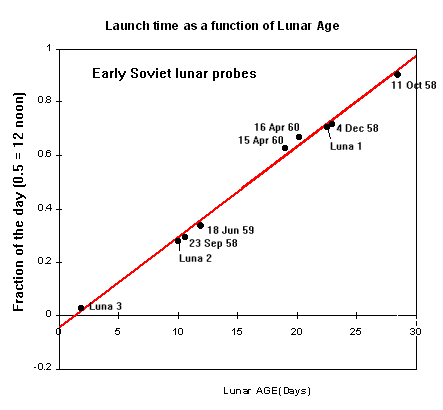
A lunar declination constraint?
It is somewhat surprising that
the lunar age of these launch attempts are spread over the whole range
of lunar phases. So, was there any other launch constraint that these launch
attempts had to obey. The table of launches shows that the declination
of the Moon at arrival was always negative. We can use the declination
phase plotting method developed by Richard S Flagg (See "Mission
profiles of 7K-L1 flights") and plot the E-1/2/3 mission in the declination
phase/Age diagram. From the figure below it is again evident that the declination
of the Moon for all launch attempts were negative! (This diagram shows
the age/declination phase at launch - not arrival).
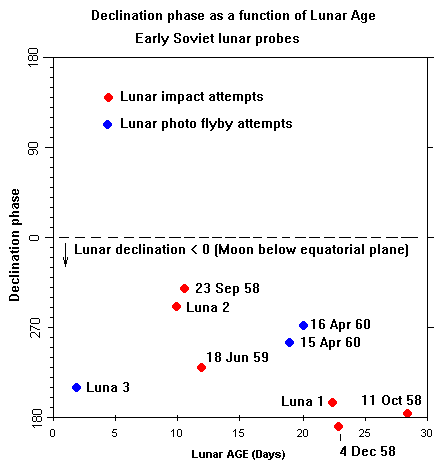 The explanation to this fact
has been given in (1), where the author states
that a negative lunar declination requires less injection energy.
The figure below shows two computer simulations of the flights of Luna
2 and the launch attempt on 4 December 1958. It seems that there were rather
strict limitations on the shape of the ascent trajectory. The flight path
angle could probably only be varied within a 5 degree range. Of course
one can see the advantages of a parking orbit approach where the injection
point can be varied to fit the lunar declination.
The explanation to this fact
has been given in (1), where the author states
that a negative lunar declination requires less injection energy.
The figure below shows two computer simulations of the flights of Luna
2 and the launch attempt on 4 December 1958. It seems that there were rather
strict limitations on the shape of the ascent trajectory. The flight path
angle could probably only be varied within a 5 degree range. Of course
one can see the advantages of a parking orbit approach where the injection
point can be varied to fit the lunar declination.
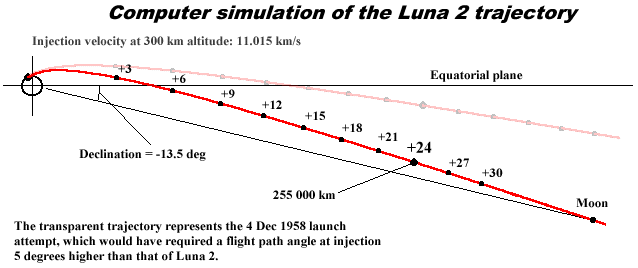
The flight time must be either
0.5, 1.5 or 2.5 days to permit viewing of the lunar approach from the Soviet
Union. A flight time to the Moon of only 0.5 days would require a very
high energy trajectory with an injection velocity of 13.7 km/s, clearly
an impossible figure! Therefore the shortest flight time to the Moon was
1.5 days.
The figure below shows a
simulation of the outbound trajectory of Luna 3. The simulation is based
on a total energy of -0.68 km2/sec2, as given in
(1).
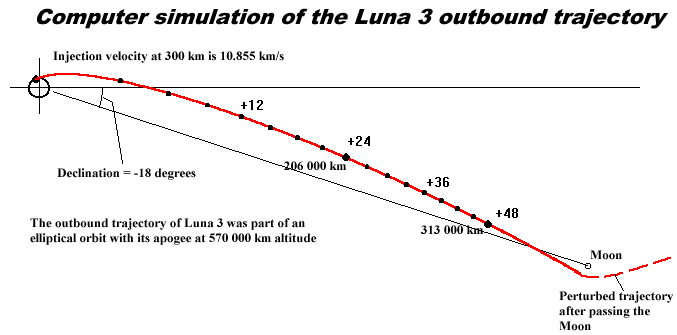
Viewing the Moon's far side
It is interesting to note that
the lunar age of the Luna-3 launch and the two E-3 probes in 1960 differ
by about 17 days! How does this agree with the fact that both types of
missions aimed at taking pictures of the Moon's far side? Well, the figure
below shows approximately which parts of the Moon's far side that were
illuminated at the time of Luna-3 and the E-3 launches. As can be seen
from this simple diagram, the age of the Moon at the time of launch of
the E-3 probes permitted the imaging of the areas of the Moon's far side
not covered by Luna-3!
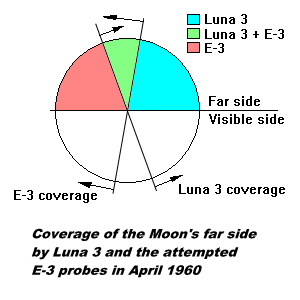
References
-
Sedov,
Leonid I, "The Orbits of Cosmic Rockets Towards The Moon", presented at
the American Rocket Society's 14 th Annual Meeting, Sheraton Park Hotel,
Nov 16-20, 1959, ARS paper no 1051A-59.
-
Asif Siddiqi,
"First to the Moon", JBIS, Vol. 51, pp. 231-238, June 1998.
-
"S Baykonura: s lune, marsu,
venere: vospominaniya veteranov Baykonura (Moscow, 2001)", in which the
attempted launch times for three flights that never made it off the pad
are given:
Sep 06 1959 0349 Moscow
Time (0049 UT)
Sep 08 1959 0540:41 Moscow
Time (0240:41 UT)
Sep 09 1959 0640:03 Moscow
Time (0340:03 UT)
Deep
Space Chronicle

 The
table below lists the known launches in the E-1, E-2, and E-3 series of
lunar probes. It is also known that the first E-1 probe was scheduled for
August 18, 1958, but postponed to September 1958 when the first U.S. Pioneer
probe failed on August 17(2). The next attempt
took place on 23 September, i.e. at roughly the same lunar age as that
of the planned attempt the month before. When the launch attempt failed
on 23 September the pressure to beat the U.S. to the Moon caused Korolev
to launch the next rocket to compete with the next Thor-Able Pioneer probe
planned to be launched on 11 October 1958.
The
table below lists the known launches in the E-1, E-2, and E-3 series of
lunar probes. It is also known that the first E-1 probe was scheduled for
August 18, 1958, but postponed to September 1958 when the first U.S. Pioneer
probe failed on August 17(2). The next attempt
took place on 23 September, i.e. at roughly the same lunar age as that
of the planned attempt the month before. When the launch attempt failed
on 23 September the pressure to beat the U.S. to the Moon caused Korolev
to launch the next rocket to compete with the next Thor-Able Pioneer probe
planned to be launched on 11 October 1958.




